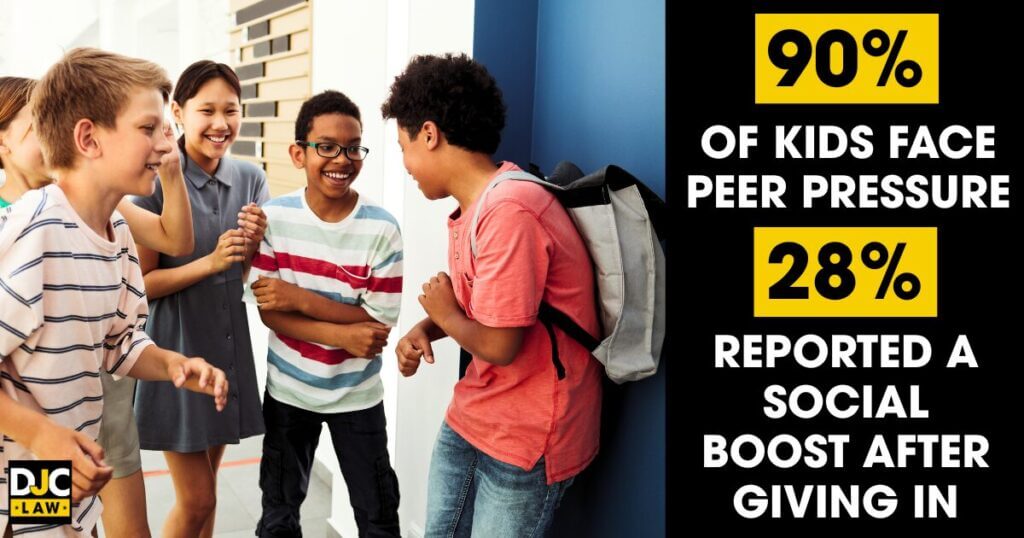Letting your children walk home from school alone may feel like a straightforward “Yes” or “No” decision, but many parents are worried about the potential for child endangerment charges. The world is a dangerous place, and laws vary heavily based on where you are in the country.
Currently, no federal law prohibits parents from allowing their children to walk to and from school. In essence, it’s an issue that’s been firmly left up to the states. Before deciding where you stand, it’s crucial to familiarize yourself with the laws where you are.
Here’s what every parent must know about the legal age for allowing kids to walk home from school alone. If your child is ever injured or harmed while walking home alone, consulting an experienced personal injury lawyer can help ensure your family’s rights are protected.
Key Takeaways
- No federal law dictates a minimum age when parents may allow their children to travel to school alone. Instead, the Every Student Succeeds Act actually protects parents from civil and criminal charges.
- States have the right to enact laws imposing age limits on children walking alone in public places. A few states, like Maryland, set hard age limits, whereas others have state or local laws that automatically leave it up to the parents. Note that school policies may also come into play.
- Experts, including the American Academy of Pediatrics (AAP), differ on the suitable age for when children should walk to school unaccompanied, but most settle somewhere between the ages of eight and ten.
- Parents are asked to monitor their children’s mental and emotional capabilities, maturity, and ability to follow rules before they make the decision themselves.
- Teach kids to walk to school for the first time through route familiarization, educating them on traffic rules and stranger danger, as well as how to use a cell phone and what to do in an emergency.
- If you’re facing charges over your decision to send your child to school alone in a state with stricter legal guidelines, speak to an attorney for more information on what you can do next.
What is the Legal Age for Children to Walk Home Alone from School in the USA?
There’s no legal age for children to be able to walk to and from school by themselves because there’s no universal law addressing the issue.
According to the Every Student Succeeds Act under 20 U.S.C Section 7922, parents are protected from civil and criminal charges if they choose to allow their child to travel to and from school alone. Although this federal law empowers parents, it also allows for some wiggle room with the mention of appropriate and responsible, meaning obviously irresponsible actions could still open up parents to charges.
For example, allowing a child to cross the road to attend middle school is very different from sending a kindergartner across the entirety of Downtown Chicago.
Despite these federal protections, states may still enact laws and regulations that supersede federal regulations in their jurisdictions. That’s why parents should look to their state or municipality for further guidance to support their decisions.
Exploring State-Specific Laws on Walking Home Alone
State-specific laws vary heavily, with some states like Texas leaving it entirely up to parents by having no particular age limit at all. In contrast, others generally choose to have their own guidelines regarding adult supervision.
According to Sage Journals, just 28.5% of children who walk to school go alone today. It indicates that fewer and fewer parents choose to let their kids walk alone at an early age. Let’s look at some of the states that have firm rules on the practice:
- Illinois – Illinois doesn’t specify anything about walking to school alone. Still, it does mandate that children under the age of 14 cannot be left home alone, which many parents also choose to apply to other activities.
- Maryland – Maryland has a law directly addressing the issue. No child under eight can be left unaccompanied and must have someone who’s at least 13 years old with them at all times.
- North Carolina – North Carolina doesn’t have a law, but it strongly recommends that children under eight shouldn’t be left alone, including those walking home unsupervised.
Disobeying a guideline isn’t a crime and can’t lead to civil or criminal charges, but ignoring an actual law will land you in hot water. Remember, state law trumps federal law, so you can’t use the Every Student Succeeds Act as a shield.
Variability Across States: Key Legal Considerations
What’s acceptable in one jurisdiction may not be acceptable in another. States like Utah, Colorado, and Montana have chosen to enact laws to protect parents from neglect charges when allowing their children to walk to school alone if deemed appropriate for age and maturity.
In contrast, other states haven’t enacted such protections, and parents may be at risk if they try to foster the independence of their children too soon. For example, Parents.com reported on a story from 2024 where a mother who allowed her 10-year-old son to walk alone was arrested in Georgia for child neglect.
Exceptions and Special Circumstances in Law
The Every Student Succeeds Act is a federal law that acknowledges the rights of parents to make their own decisions on whether to allow their children to walk to and from school unsupervised. It prioritizes parental discretion, and in states without specific laws, federal law would be used instead.
How these laws are applied varies heavily, with many states taking an extremely lax view on the issue. A child’s maturity is one such aspect that will be factored into whether to take action, rather than just their age. Likewise, the environment they’re in will also matter.
For example, there’s much more acceptance of children walking alone in small rural communities where everyone knows everyone, compared to major urban areas with high crime rates.
Again, consult your local regulations, but also think about your local community and what’s acceptable there. What are other families doing? Is your kid mature enough to walk alone? Are other children safely walking to school?
Expert Recommendations on Age and Independence
Expert recommendations vary on when a child is of an appropriate age. However, the American Academy of Pediatrics (AAP) often mentions ten years old as an excellent starting point for assessing a child’s maturity level.
Like most experts, the AAP doesn’t specify a hard age-based line but a rough recommendation. Instead, the age guideline is a starting point for considering when a child is independent enough to begin doing things like walking to school unsupervised.
It’s organizations like the AAP that states with laws on children being unsupervised often take their guidance from.
Child Development Experts: Suggested Age Ranges
Child development specialists claim that children are generally ready to begin exploring their independence from as young as eight. Although experts differ on the matter, most settle on an age range of eight to ten.
For example, Psychology Today discussed the issue, and Dr. Mariah G. Shug, a developmental psychologist and associate professor at Widener University, said most children are capable of traveling to school safely by age eight.
In contrast, Dr. Humaira Abid, assistant professor at the University of Oklahoma College of Medicine, speaking for Care.com, said that age 10 is a more appropriate age for children to walk unsupervised in public and begin developing their autonomy and confidence.
Although there’s an obvious divide, most child development experts still emphasize that parents must properly prepare their children and use some common sense. For example, the National Institutes of Health said that just one in six parents allowed their youngest child to walk to school alone, with 50% citing that distance was the primary barrier.
Role of the American Academy of Pediatrics (AAP) in Advising Parents
The AAP is one of the leading authorities on child development and parenting. Although they don’t stand by a hard age line, they stress that parents must ensure their children are capable of navigating traffic safely first.
Worried parents often think about strange men trying to kidnap their children. Still, the Department of Transportation reveals that motor vehicle crashes are the biggest killers of children aged two to 14.
So, what does the AAP recommend parents do?
- Assess your child’s maturity.
- Ask whether your kid understands traffic rules.
- Consider your child’s cognitive abilities.
- Teach your children about pedestrian safety.
Only when your child checks these boxes should they be considered ready to safely travel to and from school without you.
Assessing Readiness: Factors to Consider Before Allowing Independent Walks
Is your child ready to walk independently? If the law allows for it, it’s up to you to decide whether your child is ready. Age, personality, maturity, and environment are some of the factors you must consider before deciding whether your child is ready.
Child safety experts recommend that parents consider the route they’ll be taking and their kids’ attitudes and actions before giving them the green light. Here are the top three factors all parents must consider.
Evaluating Your Child’s Maturity and Decision-Making Skills
Cognitive and emotional development don’t follow the same trajectory for every child. Some kids mature early, whereas others are late bloomers.
So, what are some of the key indicators parents should look for?
- Obedience – Can your child follow clear rules in daily life without being constantly reminded?
- Judgment – How does your child react in unfamiliar situations, like making eye contact with strangers or shying away?
- Memory – Can your child memorize their route?
- Focus – Does your child stay alert when they’re out in public, or do they get easily distracted?
- Traffic Safety – Can your kid follow best practices for crossing the road, such as looking both ways and crossing at the appropriate time?
- Independence – Is your child comfortable with being left on their own?
Ultimately, if you feel like your child has all these things, take your child on a mock walk. In other words, this is where you’ll walk along a pre-planned route, with you shadowing your child from a safe distance.
Safety of the Surrounding Environment and Route
Children who are ready to walk alone may be unable to do so if they live too far away from school or the route they must traverse is dangerous. It’s an issue especially pertinent to parents living in major urban areas.
But what constitutes a “safe” route?
- Crosswalks – Are there well-marked crosswalks available?
- Sidewalks – Do sidewalks cover the entirety of your child’s route?
- Traffic - How many busy roads are there, driveways, or on-street parking obstacles to be aware of?
- Traffic Signals/Crossing Guards – If there are any major intersections, are there any designated guards or signals to help them cross?
- Friendly Faces – Will they encounter known family, friends, neighbors, or teachers along the way?
- Distance – How long is the route? Around a mile is a reasonable maximum for younger children.
- Lighting – Will their route be well-lit in the morning and afternoon?
Even if the route looks safe enough, think about what they’ll encounter along the way. Major red flags include abandoned buildings, isolated pathways (like tunnels), and homes with aggressive pets.
Remember, just because your child wants to be brave and independent doesn’t mean you should take a risk.
Peer Influence and Social Dynamics
Think about their friends and classmates, and how they interact with them. If available, walking in groups with neighbors can be a great idea and reassure parents. Of course, this also raises the potential issue of them goofing off in the process and making risky moves, such as taking shortcuts or playing near the roads.

Don’t discount the impact of peer pressure when your kids walk to school. According to a survey taken by Study.com, 90% of kids faced peer pressure, and 28% said their social standing had been boosted when they gave in to it.
Is your child being peer pressured? How liable are they to give in to peer pressure? Ask yourself honestly and judge whether the answers make it safe for your child to travel to school unsupervised.
Safety Preparations for Walking Home Alone
Guidance across all states and from major child developmental organizations, including the AAP, mentions proper preparations for parents who allow their children to travel to school alone. This includes providing them with proper navigation skills and implementing systems that allow them to communicate in an emergency.
Teaching Children Navigation Skills and Safety Protocols
Navigation skills for a child mean teaching them the route to and from school. Your child should know precisely where to go without thinking about it because a lost child is a crisis that can put them in serious danger.
Follow these steps to equip your child with the skills and confidence needed to gain their independence:
- Step One – Walk the route together. Try walking a few steps behind and gradually increasing the distance until they know the route like the back of their hand.
- Step Two – Expand the route by showing them the areas around their route. Identify alternative safe routes they can take, if necessary. These should include familiar places you might visit together, like parks or major landmarks.
- Step Three – Ask them to recite the route they must take to school at random. Until they can get it right, they’re not ready to go alone.
Alongside route familiarization, you should show them how to handle pedestrian safety. Teach them the essentials, including obeying traffic signals and only crossing at designated crosswalks. Also, talk to them about personal safety, including recognizing and avoiding potentially hazardous situations.
Encouraging the Use of Mobile Phones and Emergency Contacts
Mobile phones are an essential communication tool for your children if they get into trouble. According to Common Sense Media, one in four kids has a smartphone by age eight, so it’s not as uncommon as you might think.
Ensure your child knows who their emergency contacts are and how to reach them through their phones. This should include the emergency services and how to use their emergency call features if their phone is locked.
You might also want to think about installing apps that allow you to monitor your kids via GPS. This allows your child to be independent while still giving you the power to see precisely where they are in real-time.
Setting Up a “Walk Buddy” System for Added Security
The buddy system ensures that children aren’t walking alone but with someone else. It allows your child to go to school with a friend, and they can look out for each other. Some communities may even establish group walking arrangements with the neighborhood, since everyone attends the same school anyway.
Like you would with anyone else you leave your children with, ensure you’re pairing them up with someone as mature as they are.
Benefits of Allowing Children to Walk Home Independently
Walking home independently is an opportunity for you to help your child transition to a new stage of maturity. It’s a way to get them ready for the world and help them develop as they get older.
Of course, it’s also a convenient way to get around, but the best way to view it is as an opportunity for them to demonstrate their resilience. Yes, there are risks, but the benefits outweigh the risks for most children.
Promoting Physical Fitness and Mental Well-Being
Physical fitness is essential for any growing child. It’s no secret that kids don’t get enough exercise, with just 20-28% of children aged between six and 17 getting 60 minutes of daily physical activity, per the University of Kansas Medical Center.
Walking is an easy way for them to get those minutes of exercise in, but it also has some big mental and emotional benefits. Here’s a breakdown of the benefits:
- Improve heart health.
- Build muscle strength.
- Reduce obesity risk.
- Encourage better posture.
- Improve muscle coordination.
- Increase energy levels.
- Promote better sleep.
- Reduce anxiety and stress.
- Improve focus.
- Improve mood.
These are just a taste of some of the benefits of letting your child walk instead of driving them or forcing them to take the bus. If practical, it’s one of the best habits you can instill in them from the very beginning.
Addressing Parental Concerns and Common Myths
Letting your children walk to school alone may feel risky, but the fact is that millions of children walk to school every year without any issues. Don’t allow sensationalist media reports or isolated stories to cause you to wrap your child in bubble wrap, as this can cause arrested development and long-term harm.
Understanding the actual risks will enable you to make an informed decision based on where you live.
Risk vs. Rewards: Understanding Modern Safety Statistics
The U.S. has never been safer for children than it is today, particularly regarding road traffic safety.
According to the Children’s Hospital of Philadelphia, an average of 626 children die as pedestrians every year. That’s not 626 in the City of Brotherly Love, but the entire country. To put this in perspective, 626 children out of 74 million in percentage terms is a risk of 0.00085%.
You may have heard that over 400,000 children are reported missing every year, but that doesn’t mean kidnapping. Children are reported as missing for any number of reasons. According to the Office of Juvenile Justice and Delinquency Prevention, just 100 children are actually abducted by strangers every year nationwide.
In short, the statistics simply don’t bear out the scary reality that the hack service journalism reporter likes to paint. With these stats in mind, parents should remember that sending their child to school alone or with an older sibling is nowhere near as hazardous as many would have them believe.
How to Combat Fear and Anxiety About Walking Alone
Parental anxiety about sending your kids alone to school is a natural part of being a parent. It’s normal to overestimate the potential dangers and underestimate the resourcefulness and intelligence of your kids.
Ultimately, the best antidote is educating yourself on the statistics, engaging with your community, and gradually releasing your grip on your child via gradual independence and following important safety tips. You’ll always be nervous the first few times, but the best way to focus your mind is on the facts, not on the absolute worst-case scenario.
Conclusion: Balancing Safety and Independence for Children Walking Home
Your child may be pestering you to be able to walk to school by themselves, but the decision must always rest with you. Analyze your child’s abilities objectively and ask yourself honestly whether they’re ready.
But none of your judgment supplants what the law of your state says. If you’re unfamiliar with the rules in your state or are being sued or charged over sending your child to school alone, you need a law firm you can trust. With a 99% case success rate, DJC Law is Austin’s number-one law firm. To learn more, contact us for your free consultation today.
Frequently Asked Questions About Sending Children to School Alone
What are the biggest safety risks children face when walking to school?
The biggest risks parents should be concerned about are traffic accidents, getting lost, and stranger danger. The best way to combat these risks is to gradually introduce your kids to the world and don’t allow them to walk alone until you’re confident that they know what they’re doing.
What if my child feels anxious about walking alone?
It’s totally normal for your child to feel as nervous as you. Start by walking with them before gradually increasing the distance between yourselves until they no longer need you. Along the way, reassure them that you trust them to be able to handle themselves through sound decisions and peer support.
What should I teach my child to do if they experience an emergency?
Show them how to call 911 on their phones and identify safe places. For example, tell them to go into a school, a store, or a police/fire station. Also, show them trustworthy adults to approach if they need help, such as adults with other children and authority figures like their neighborhood police officer.


